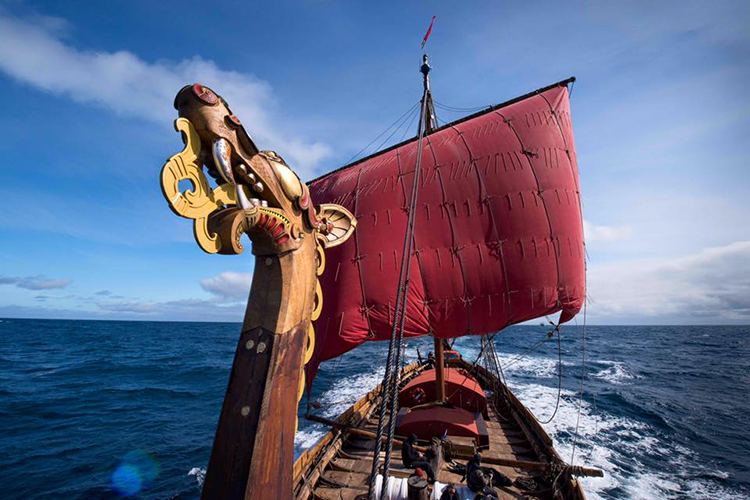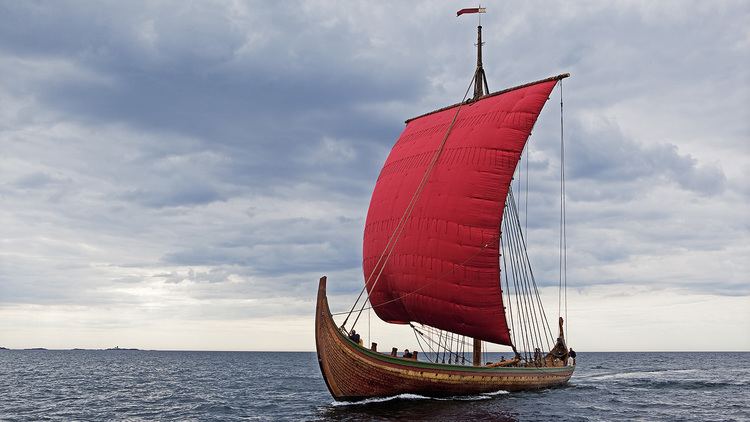Owner Sigurd Aase Laid down March 2010 Construction started March 2010 Draft 2.5 m | Builder Viking Kings AS Length 35 m Launched 5 June 2012 Tons burthen 95,500 kg | |
Name Draken Harald Hårfagre (English Dragon Harald Fairhair) Type Viking longship (Skeid) | ||
Draken harald h rfagre the construction of a viking dragon ship
Draken Harald Hårfagre (English: Dragon Harald Fairhair) is a large Viking longship built in the municipality of Haugesund, Norway. Draken Harald Hårfagre brings the seafaring qualities of a warship from the old Norse sagas to life. It is a ship that combines ocean-crossing sailing capabilities with a warship's use of oars.
Contents
- Draken harald h rfagre the construction of a viking dragon ship
- North sea sailing with draken harald h rfagre
- Construction
- An oceangoing Norwegian warship
- Norwegian boatbuilding traditions
- Launch and Maiden voyage
- Expedition America 2016
- References

North sea sailing with draken harald h rfagre
Construction
Building began in March 2010. Construction was funded by Sigurd Aase, described as a "Norwegian oil and gas tycoon."
An oceangoing Norwegian warship
The longship is a '25-sesse' (25 pairs of oars) – in other words, it is equipped with 50 oars. Each oar is powered by two men. Under sail it requires a crew of 30 people.

Draken Harald Hårfagre is 35 metres (115 ft) long with a beam of approximately 8 metres (26 ft) and a displacement of about 95 metric tons. The longship is constructed in oak and carries 260 square metres (2,800 sq ft) of sail.
Draken Harald Hårfagre is the largest Viking ship built in modern times. In the Viking age, an attack carried out from the ocean would be in the form of a "Strandhogg", i.e. hit and run tactics, being highly mobile. By the High Middle Ages the ships changed shapes to become larger and heavier with platforms in the front and back. This was done for the sake of sea battles, that made it possible to board ships that lay alongside each other. In the 13th century, this tactic was well known and widely used in Scandinavia. The law of the land in those days (Norwegian: Gulatingsloven) included standards that required Norwegian provinces (fylker) to cooperate in supplying 116 such warships of 50 oars size (Norwegian: 25-sesser) (25 pairs of oars) for duty in the Norwegian fleet of warships.
Norwegian boatbuilding traditions
Copies of Viking ships are usually based on interpretations of archaeological material. But in the construction of Draken Harald Hårfagre an alternative method has been used. It was decided to begin with the living tradition of Norwegian boatbuilding, with roots that can be traced directly to the Viking Age. The foremost Norwegian traditional boat builders are involved in the project. Their knowledge of traditional boatbuilding is supplemented with the results of investigations carried out on archaeological material, source material in Norse literature, literature from the same period from foreign sources, iconographic material, etc. The goal of the project is to recreate in this manner an oceangoing warship of 50 oars taken right out of the Norse Sagas.
Launch and Maiden voyage

The launching of the longship took place in the summer 2012. Because no one today has real experience handling a Viking ship of this size, the initial period was be one of exploring how to sail and row the ship, and for experimentation with the rigging along the coast of Norway.

In summer 2014, skippered by Swedish captain Björn Ahlander, the longship made its first real expedition, a 3-week passage under sail from Norway to Merseyside. There it was hosted by the Liverpool Victoria Rowing Club. It also visited various other locations around the coast of the British Isles including the Isle of Man, Western Isles, Orkney and Shetland.
Expedition America 2016
The ship left its home port of Haugesund, Norway on the 26th of April, 2016, bound for Newfoundland, the aim being to explore and retrace the first transatlantic crossing and the Viking discovery of the New World. The route included stops at the Shetland and Faroe Islands, Iceland, and Greenland, before landfall on Newfoundland was finally achieved on the 1st of June that year. Future stops are planned along the Atlantic Canadian and American coast.
The schedule of the voyage is:
(*Approximate dates)
In mid-July 2016 doubts were raised about the ship's ability to visit US destinations in the Great Lakes. The U.S. Coast Guard deemed it a commercial vessel, requiring a pilot per a 1960 law. The total cost of piloting was estimated at $400,000. Sons of Norway raised over $60,000 in order to help pay the pilot fees. On 4th August 2016 Viking Kings issued a press release declaring that Green Bay would be the ship's last stop in the Great Lakes, planning to make its next stop in New York in September.
